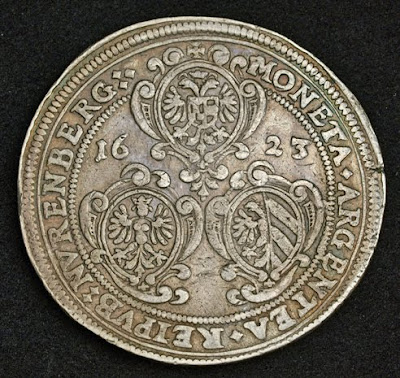

German States Coins - Nurnberg Silver Thaler 1623, Ferdinand II Holy Roman Emperor
beautiful, rare and early silver thaler, struck by the City of Nurnberg with the titles of Emperor Ferdinand II, who was one of the important key-figures of the 30-Years war and the main supporter of the Holy League (the catholic anti-protestant alliance).
Obverse: Coat of arms of Holy Roman Empire above, between arms of Nurnberg below. Date (1623) in fields.
Legend: + MONETA . ARGENTEA . REIPVB . NVRENBERG :.
Reverse: Imperial crown above nimbate double-headed imperial eagle.
Legend: + FERDINANDI . II : D:G: ROMAN : IMPER : SEMP AVGVST : D : P :
Mint Master: Georg Nurnberger (privy mark: cross)
Reference: Davenport 5636, Kellner 230b, KM-52(b).
Mint Place: Nuremberg (as free City within the Holy Roman Empire).
Weight: 28.93 gm
Diameter: 41 mm
German Coins, German coinage, German silver coins, German States Coins, Coins of Germany, German Gold Coins, German commemorative coins, German Imperial Coins, Numismatic Collection, Coins of the German Empire, Coins of Germany best silver coins for investment, silver coins, German East Africa coins, old coins, coin collecting, rare coins, world coins, foreign coins, heritage coins, silver ira investment, silver bullion coins, silver coin collection investors, investment coins, antique coins, Unique Silver Coins, collectible coins, Münzen Deutschland, silbermünzen, Münzen aus Deutschland, Münzen Deutsches Kaiserreich.
Free Imperial City of Nuremberg
The Free Imperial City of Nuremberg (German: Reichsstadt Nürnberg) was a free imperial city — independent city-state — within the Holy Roman Empire. After Nuremberg gained piecemeal independence from the Burgraviate of Nuremberg in the High Middle Ages and considerable territory from Bavaria in the Landshut War of Succession, it grew to become one of the largest and most important Imperial cities, the 'unofficial capital' of the Empire, particularly because Imperial Diets (Reichstage) and courts met at Nuremberg Castle. The Diets of Nuremberg were an important part of the administrative structure of the Empire. The Golden Bull of 1356, issued by Emperor Charles IV (reigned 1346–78), named Nuremberg as the city where newly elected kings of Germany must hold their first Imperial Diet, making Nuremberg one of the three highest cities of the Empire.
The cultural flowering of Nuremberg in the 15th and 16th centuries made it the center of the German Renaissance. Increased trade routes elsewhere and the ravages of the major European wars of the 17th and 18th centuries caused the city to decline and incur sizeable debts, resulting in the city's absorption into the new Kingdom of Bavaria on the signing of the Confederation of the Rhine in 1806, becoming one of the many territorial casualties of Napoleon's Great French War in a period known as the German Mediatisation.
Ferdinand II, Holy Roman Emperor
Ferdinand II (9 July 1578 – 15 February 1637), a member of the House of Habsburg, was Holy Roman Emperor (1619–1637), King of Bohemia (1617–1619, 1620–1637), and King of Hungary (1618–1625). His rule coincided with the Thirty Years' War.